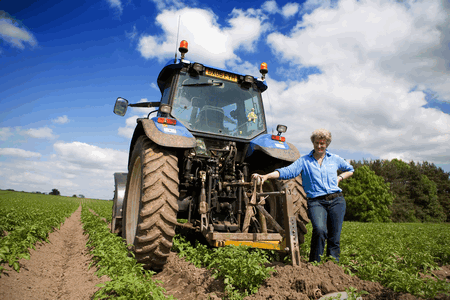Cereal straw value to soil structure and as a nutrient might be too valuable to lose

Straw’s value in improving soil structure, and helping reduce soil erosion, means it is a valuable resource, Sarah Olney of ECSFDI says.
Fertiliser use and soil structure were key subjects at the Potato Council’s West Midlands potato day. Mike Abram reports
Growers should be aiming to sell cereal straw for at least £45/acre, according to Sarah Olney from the England Catchment Sensitive Farming Delivery Initiative. Otherwise its value in increasing soil organic matter was too great to lose.
“Soil organic matter is incredibly important,” she told growers. “There are masses of advantages to increasing levels in soils.”
Higher soil organic matter helped to improve soil structure reducing the risk of erosion, she explained. Easier working land would also reduce diesel costs, and require less fertiliser because uptake would be better.
“And if you irrigate, you will use less water, because the soils water holding capacity is much higher.”
With prices more than £400/t for potash, straw’s value as a nutrient was also increasingly valuable, Brian Chambers of ADAS said. “Wheat straw has lots of potash – it is probably worth about £5-6/t, while barley, which has more potash, is worth £6-7/t.”

An alternative was to sell the straw to a livestock farm in return for resulting slurry or farmyard manure.
Organic manures had trebled in value with the rise in fertiliser prices, he said. “About 100m tonnes are being recycled to farmland, worth about £500m.”
There were three keys issues to using it effectively, he said. “You need to know what you are applying, apply it accurately and evenly, and use decision support software or RB209/Potato Council leaflets to estimate the nutrient supply for crops.”
Those leaflets contained typical figures for N, P, K, S and Mg, but it was more accurate to have it analysed by a laboratory. “It only costs £30-£40 often the hassle of taking it to a lab is greater.”
An alternative was to use an on-farm slurry testing kit, such as a hydrometer, or a Quantofix or Agros N meter.
When spreading solid manures the key was to drive closer to improve accuracy, he said. “The general rule of thumb is when you think you have got it right, drive a yard closer.”
The MANNER decision support system would help estimate what N would be available for crops. Investigations suggested for potato and sugar beet crops the system was a good predictor for the N replacement value for manures, Prof Chambers said.
Organic manures also supplied valuable levels of potash and phosphate to the following crop, he said. About 50-60% of the phosphate and 80-90% of the potash were available to the next crop grown from FYM, slurry, poultry litter or green composts.
With current prices that gave poultry litter, cattle FYM and slurry (see table) a nutrient value worth over more than £350/ha, he calculated. Green compost was worth about £200/ha.
Typical fertiliser value of organic material applications (250kg/ha total N) | |||||
Manure type (dry matter) | Application rate (cu m or t/ha) | Crop available N (kg/ha) | Total phosphate (kg/ha) | Total potash (kg/ha) | Value (£/ha) |
Poultry litter (60%) | 8 | 70 | 200 | 145 | 363 |
Cattle FYM (25%) | 40 | 40 | 140 | 320 | 380 |
Cattle Slurry (6%) | 80 | 80 | 100 | 280 | 342 |
Green compost (60%) | 30 | Low | 90 | 195 | 198 |
Assumes spring surface application. N = 80p/kg P = 110p/kg K = 60p/kg | |||||

